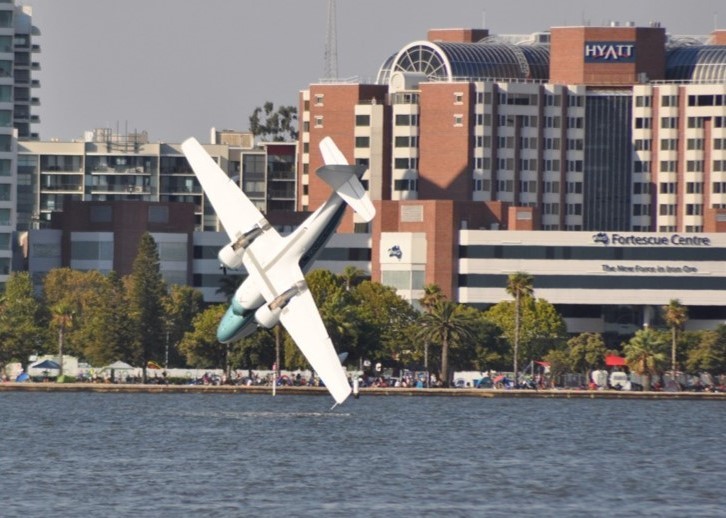
The ATSB is calling for the implementation of improved tools and guidance for airshow display approvals and oversight following its investigation into a high profile fatal accident at an Australia Day air display in Perth in 2017.
A pilot and passenger were fatally injured when their Grumman G-73 Mallard amphibious aircraft aerodynamically stalled over the Swan River and collided with the water during the air display, which was part of the City of Perth’s Australia Day Skyworks event.
The ATSB’s investigation into the accident established that the Mallard was to conduct two circuits over Perth Water, ‘in company’ (that is, following behind at a prescribed distance) with a Cessna Caravan aircraft. The pilot of the Caravan had previous experience operating in this location, including participating in this air display. Following the Caravan was intended as a risk mitigator against the Mallard pilot’s unfamiliarity with display flying over the Swan River.
However, after conducting two passes in company, with both aircraft departing the display area, the pilot of the Mallard subsequently requested of, and received approval from, the air display ‘ringmaster’ to conduct a third pass. The aircraft then returned to the display area without the Caravan and in a manner contrary to the standard inbound procedure, requiring turns at higher bank angles and lower altitudes within a confined area to become established on the display path.
The ATSB investigation found that the aircraft stalled at an unrecoverable height. Had the Mallard re-entered the display area using the standard procedure for the air display, the manoeuvres required to position for the third pass would have been relatively benign with a significantly reduced risk of mishandling the aircraft. Further, the pilot’s decision to carry a passenger was also contrary to the requirements of the display approval and increased the severity of the outcome.
Having well-defined, transparent, and consistent processes for planning and approval of air displays assists in identifying risks and implementing effective mitigation strategies.
“Air displays have inherent and unique risks that everyone involved – pilots, organisers, and regulators – have responsibilities in addressing,” ATSB Executive Director Transport Safety Nat Nagy said.
“It is important that holders of these key positions have a thorough understanding of their role and responsibilities, to ensure adequate completion of safety critical tasks. Having well-defined, transparent, and consistent processes for planning and approval of air displays assists in identifying risks and implementing effective mitigation strategies.”
Mr Nagy said the investigation also highlighted that pilots can limit their exposure to risk by only participating in displays that are within their own and their aircraft’s capabilities and limitations.
“Pilots should not undertake any impromptu manoeuvres that have not been planned or practiced,” he noted.
Since the accident, CASA had independently published a revised manual of guidance for air displays in September 2017.
“The ATSB acknowledges the improvements to CASA’s manual of guidance for air displays and the associated forms,” Mr Nagy said. “But while these changes improve existing guidance, we consider that they only partially address the safety issue surrounding air display approval and oversight.”
Consequently, the ATSB has issued a formal safety recommendation to CASA calling for further improved air display approval and oversight tools and guidance, and enhanced procedures to ensure the suitability air display organisers, coordinators and participants.
Read the report: Collision with water involving Grumman American Aviation Corp G-73, VH-CQA, 10 km west-south-west of Perth Airport, Western Australia, on 26 January 2017


